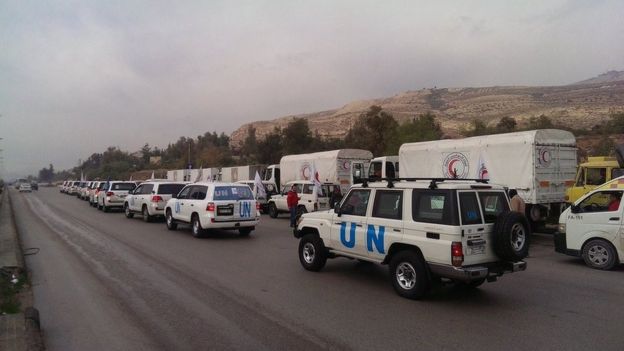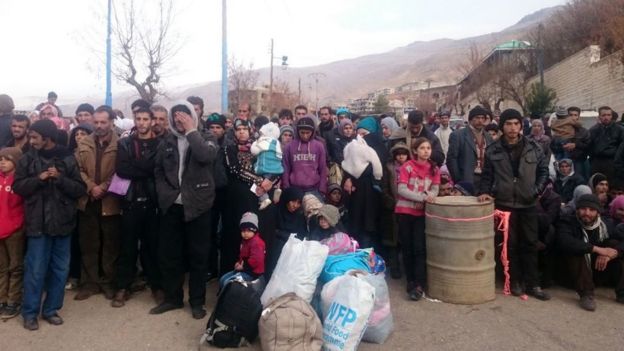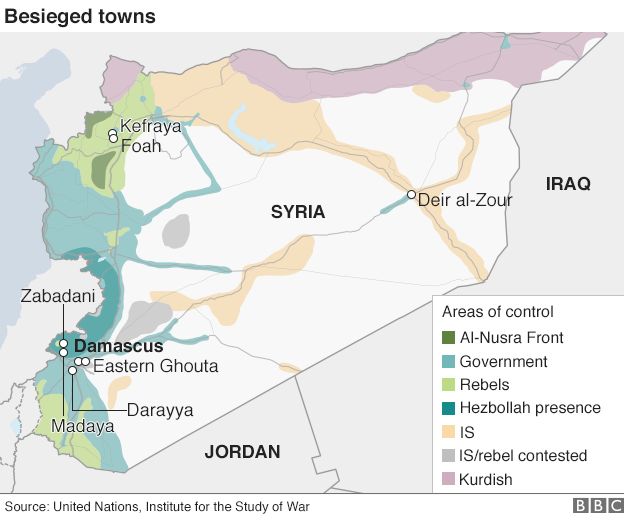An aid convoy has begun entering the besieged rebel-held Syrian town of Madaya with enough food to last 40,000 people for a month, the UN says.
Residents have been trapped there for six months by a government blockade and have received no aid since October.
The UN says it has received credible reports of people dying of starvation.
Aid is also set to be delivered to two villages besieged by rebel forces in the northern province of Idlib under a deal between the warring parties.
The situation in Foah and Kefraya is also said to be extremely dire, with an estimated 20,000 people trapped there since March.

The UN posted a photo on Monday afternoon it said showed the aid convoy outside Madaya

A group of people are waiting for the aid convoy at an entrance to Madaya
The first three lorries of supplies have now entered Madaya, a BBC Arabic correspondent says, with the rest of the convoy awaiting permission to enter.
In total more than 60 lorries operated by the UN, the International Committee of the Red Cross, the Syrian Red Crescent and the World Food Programme had left Damascus for Madaya, Foah and Kefraya on Monday morning.
They were carrying basic food items – including rice, vegetable oil, flour, sugar and salt – as well as water, infant formula, blankets, medicines and surgical supplies.
At 16:30 local time (14:30 GMT), the UN’s Office for the Co-ordination of Humanitarian Affairs (OCHA) posted on Twitter a photo of the convoy as it was “about to enter” Madaya.
War of words – Lyse Doucet, chief international correspondent, BBC News, Beirut
Tens of thousands of suffering Syrians will finally get aid but this humanitarian mission was forged by a cruel conflict. Aid for rebel-held Madaya was contingent on help for government-controlled Foah and Kefraya.
Images of Madaya’s emaciated children sparked alarm in many capitals and created greater impetus but they also provoked a war of words.
Supporters of the Syrian government and its Lebanese Hezbollah allies accused rebel forces in Madaya of seizing food for themselves. Some even mocked reports of starvation. The opposition charged President Assad’s forces with more war crimes.
Today, Madaya is the face of Syria’s suffering. Two years ago, it was Yarmouk.
These are moments that mobilise the world’s sympathy but over the past year, only 10% of the UN’s requests to deliver aid to people to in besieged and hard-to-reach areas were granted. That is where 4.5 million Syrians live.
Syria’s civilians living a ‘life worse than death’
Hezbollah’s Al-Manar TV meanwhile showed a group of people, including women and children, waiting for the vehicles at an entrance to Madaya.
Madaya, which is about 25km (15 miles) north-west of Damascus and 11km from the border with Lebanon, been besieged since early July by government forces and their allies in Lebanon’s Shia Islamist Hezbollah movement.
Brice de la Vigne from the medical charity Medecins Sans Frontieres (MSF) described the situation in the town as “quite horrific”.

Mr de la Vigne, whose organisation supports a health centre in Madaya, told the BBC that more than 250 people there had “acute malnutrition”.
He added that 10 of them needed immediate medical evacuation or would die.
MSF said on Sunday that a total of 28 people – including six children less than one year old – had died of starvation in Madaya since 1 December.
However, Hezbollah has denied that there have been any deaths in the town, and accused rebel leaders of preventing people from leaving.
Once the agencies have gained access for the first time since October, the exact situation in Madaya in particular should become clearer, the BBC’s Jim Muir in Beirut says.
The UN had hoped to reach Madaya on Sunday. It was not clear what caused the delay but our correspondent says negotiating access across battlefronts in a siege situation has always been a tricky business.
‘Ambiguous information’ in local media – BBC Monitoring
Madaya is a major talking point in the Arabic media, with attitudes ranging from sympathy for its trapped inhabitants to anger at allegedly fake imagery.
Two pan-Arab satellite television channels that take a firmly pro-rebel line – Saudi-funded Al-Arabiya and Qatar’s Al Jazeera – say the Syrian government and its Hezbollah allies are “starving Madaya to death”.
But Syrian state and allied media dismiss the “rumours”. Al-Baath newspaper accuses Al Jazeera and Al-Arabiya of a “misleading campaign, using photos of displaced and sick people from all over the world”, and says the rebels are using civilians as human shields,
Some commentators try to take a broader view. Muhammad Kharrub in the Jordanian newspaper, Al-Rai, complains that the rebels themselves are besieging government-held towns, and Mahir Maqlad in Egypt’s Al-Ahram notes that both sides “keep their information ambiguous to suit their own interests”.
It involves agreement at the top political level on both sides of the conflict, as well as individual fighters on the ground.
Blockades have been a feature of Syria’s civil war but the plight of Madaya has drawn international attention, partly due to images emerging of severely malnourished residents.
Up to 4.5 million people in Syria live in hard-to-reach areas, including nearly 400,000 people in 15 besieged locations who do not have access to life-saving aid.
In a separate development on Monday, activists said at least 12 children had been killed in an air strike on a school in the rebel-held town of Ain Jara, in Aleppo province.
What’s happening in Syria?
More than 250,000 Syrians have lost their lives in almost five years of conflict, which began with anti-government protests before escalating into a brutal civil war. More than 11 million others have been forced from their homes as forces loyal to President Bashar al-Assad and rebels opposed to his rule battle each other – as well as jihadist militants from Islamic State.
Why are civilians under siege?
All parties to the conflict are using siege warfare, encircling populated areas, preventing civilians from leaving and blocking humanitarian access in an attempt to force opponents to surrender. Shortages of food, water, medicine, electricity and fuel have led to malnutrition and deaths among vulnerable groups.
Where are the sieges?
Government forces are besieging various locations in the eastern Ghouta area, outside Damascus, as well as the capital’s western suburb of Darayya and the nearby mountain towns of Zabadani and Madaya. Rebel forces have encircled the villages of Foah and Kefraya in the northern province of Idlib, while IS militants are besieging government-held areas in the eastern city of Deir al-Zour.
BBC
 Q FM Africa's Modern Radio
Q FM Africa's Modern Radio